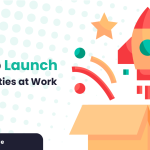
The following post is a continuation of last week’s blog on creating vibrant workplace communities. If you haven’t read it already, we encourage you to take a look at part 1 before reading this one. Now, let’s get right to it with more insights on building, managing and sustaining workplace communities that will take your company culture to the next level and make you a household name in employee experience.
Just like the work we do every day, communities can be greatly enhanced by the right technology.
I- Social media platforms have proven that communities can grow and thrive in a virtual environment
Everywhere, and at any moment, new communities are being formed on various social networking platforms. No longer bound by proximity, many have grown across continents to reach previously unfathomable scales. However, few have managed to integrate into the workplace, in large part because they often expose users to an eerily distracting amount of content, and because they leave corporate data in the hands of questionable entities. The right platform for workplace communities should be built as a fully private and dedicated environment to a given community, so as to offer a safe and secure environment for discussion and community to flourish.
II- Current work-tech platforms only do half the work
Many “Work-Tech” platforms such as Slack (communication), Microsoft Teams (organization) and Google Docs (collaboration) are not designed to build community in the workplace. While communication and teamwork are essential aspects of community building, they cannot by themselves foster a sense of belonging in the workplace. Creating community requires a safe environment for people to express their interests and identity, without the fear of being judged. The end goal of any community building platform should be to emulate a sense of belonging in its members rather than just giving them the means to communicate and organize.
III- Workplace communities need a dedicated platform to thrive
The workplace is a complicated environment to navigate for most employees. Factors such as the pressure to succeed and the competitive environment make creating real connections with colleagues a daunting task. However, if employees are given a dedicated environment where they can find and interact with colleagues who share common interests, then they can overcome these initial barriers and begin to integrate with communities they care about. On such a platform, employees are able to freely join communities that reflect their own interests, engage with them and join in-person events that promote real human connection.
That concludes this two part series. We hope you enjoyed, and feel more comfortable with building your own communities@work.
Take some time to discover MixR and find out if it’s the right solution for your community-building needs.







